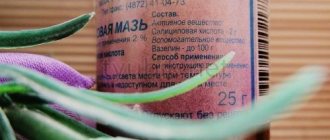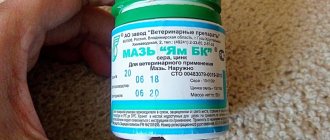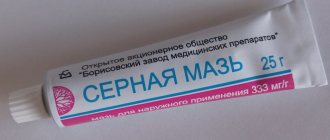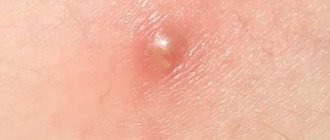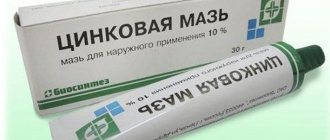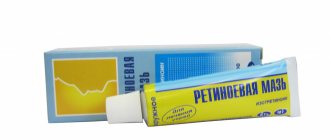Balsamic liniment (also known as Vishnevsky's ointment or liniment) is widely used in medical practice for various diseases.
The high effectiveness and safety of the drug made it especially popular. It is often used without medical prescriptions, self-prescribed for suppuration and various purulent ulcers and wounds that need to be cleansed of necrotic contents, making it impossible for them to heal.
The drug was created by Russian surgeon A.V. Vishnevsky in 1927. An effective medicine does not lose its popularity today, despite the abundance of antibiotics. Having a minimum of contraindications, the ointment can be used for most injuries and many diseases in children and adults. The product is now found in most home medicine cabinets in Russia and the CIS countries.
Composition and medicinal properties of the ointment
Balsamic liniment has birch tar as its main active ingredient.
Vishnevsky's ointment contains only 3 components, each of which enhances the effect of each other.
- Purified birch tar. This component is natural. It is obtained from birch bark. Tar looks like a thick, dark, viscous liquid. This is the strongest natural antiseptic that is effective against most pathogenic bacteria that can cause inflammation in humans. Additionally, the component actively enhances blood circulation at the site of application and increases the ability of tissues to regenerate. The property of tar to eliminate pain, burning and itching is also valuable. Its use is also possible on wet wounds, since the substance helps dry them. For burns, wounds, bruises and wen, tar has been used for a long time.
- Castor oil (a number of manufacturers replace it with fish oil, but this is not a desirable option). The component in the ointment enhances its ability to quickly penetrate tissue. Additionally, the substance in combination with tar also acts as a strong sedative for the affected skin, relieving pain and itching.
- Xeroform. Promotes drying of the wound surface and enhances the antiseptic effect of the drug.
The ratio of active ingredients in the drug is as follows:
- 94% castor oil,
- 3% tar,
- 3% xeroform.
The smell of the ointment is specific and very pungent, which is provided mainly by tar. Even under a bandage, it is clearly noticeable to others. The color of the drug, depending on the manufacturer, is brown or dark dirty yellow.
The drug is produced in the form of liniment, which is thinner than ointment and penetrates tissue more easily.
The main medicinal properties of Vishnevsky’s ointment (liniment) are as follows:
- local immunomodulatory;
- pulling (cleansing);
- antiseptic;
- bactericidal;
- healing;
- pain reliever;
- antipruritic.
In some cases, it is recommended to mix the medicine with Shostakovsky balm (vinilin). The drugs enhance each other’s actions and have an even more active effect on the body.
The ability of the drug to stimulate the regeneration of the skin and deeper tissues allows it to be used to treat third-degree burns, which in this case, after healing, do not leave strong scars, which is of great importance for tissue damage in open areas of the body.
In addition to skin lesions and injuries, the ointment is also used for internal inflammation of the genitourinary system and mammary glands.
The drug is prescribed in the following areas of medicine:
- gynecology;
- dermatology;
- traumatology;
- surgery;
- urology;
- proctology;
- dermatology;
- cosmetology.
The product is available over-the-counter because it is not an antibiotic or hormonal drug.
Levomekol
Perhaps one of the most famous ointments for drawing pus from a wound. Levomekol is considered the most effective drug among non-hormonal drugs. In addition to the fact that the ointment gets rid of pus, it fights the causes of its appearance - harmful bacteria. The composition contains a regenerating substance that helps the wound heal faster. "Levomekol" can be used not only on wounds, but also for burns, hemorrhoids, to treat acne and gum disease. This drug is ideal for purulent wounds, it gives a good effect when applied under a bandage, can be used in children from 1 year old, and contains almost no auxiliary components. Among the disadvantages is the possibility of allergic reactions.
Levomekol
OJSC "Nizhpharm", Russia
An ointment that has an antimicrobial, anti-inflammatory, drying effect and is used for: Purulent wounds (including those infected with mixed microflora) in the first (purulent-necrotic) phase of the wound process.
from 38
1236
- Like
- Write a review
How to use Vishnevsky ointment correctly?
Vishnevsky ointment is actively used to treat purulent abscesses, due to which they resolve and heal faster. Thus, the inflammatory process, which could last for a week or 10 days, is reduced on average to a day.
The boil ripens, the skin covering it bursts and purulent contents come out. Thanks to the ointment, no further suppuration occurs, and the wound heals without scar formation.
When should you use Vishnevsky ointment:
- Acne;
- Inflammation of the gynecological area;
- Gangrene, thrombophlebitis, varicose veins, trophic ulcers, endarteritis;
- Frostbite, burns;
- Bedsores;
- Psoriasis;
- Dropsy, swelling.
Ichthyol
Budget ointment for suppuration of wounds, which was used by our grandmothers. “Ichthyol” has long proven its effectiveness in suppressing pathogenic flora. In addition, the ointment has an irritating effect, stimulating improved blood flow. Therefore, “Ichthyol” is indicated not only for the treatment of purulent wounds, but also for the treatment of diseases of the pelvic organs (in women and men). The drug reduces congestion by stimulating blood circulation in the internal organs. You can buy “Ichthyol” at any pharmacy, it perfectly treats inflammatory skin diseases that cause itching, a jar lasts a long time, the product draws pus from closed wounds, helps with ingrown toenails, and has a thick consistency. The ointment has a pungent odor, and it also needs to be carefully applied to the mucous membranes.
Ichthyol
JSC "Monfarm", Ukraine; Yaroslavl Pharmaceutical Factory, Russia
Ichthyol is an anti-inflammatory agent, has a local anesthetic, antiseptic, and keratoplasty effect.
from 24
1065
- Like
- Write a review
Application of ointment
Balsamic liniment has numerous indications for use. Vishnevsky ointment must be used correctly for various diseases in order to get the highest possible results.
The main indications for the use of balsamic liniment ointment according to Vishnevsky are as follows:
- abscesses of various nature;
- trophic ulcers of diabetic nature;
- ulcers due to varicose veins;
- bedsores;
- thermal burns;
- severe chemical burns;
- frostbite;
- inflammatory lesions of the lymph nodes;
- carbuncles;
- boils;
- boil;
- extensive abrasions;
- infected purulent wounds;
- psoriasis;
- thrombophlebitis of varying degrees;
- obliterating arterial endarteritis;
- acne;
- weeping wounds on the skin;
- haemorrhoids;
- soft tissue phlegmon;
- empylem complicated by sepsis;
- osteomyelitis – purulent inflammation of the bones;
- postpartum ulcers.
These are only the main indications for treatment with Vishnevsky ointment. In addition to these, doctors recommend the drug for many other disorders.
Flucinar-N
This potent ointment for purulent wounds contains an antimicrobial component and an analogue of the adrenal cortex. "Flucinar-N" not only destroys pyogenic microorganisms, but also relieves inflammation, swelling, and pain. The drug is perfect for treating secondary infections, when the wound becomes infected from the outside or from a source inside the body. "Flucinar-N" can be used to treat varicose veins, it is indicated for children over 2 years old, it helps with atopic dermatitis and psoriasis. The ointment has few contraindications, but it can be addictive.
Flucinar N
Pharmaceutical plant Elfa A.O., Poland
Allergic dermatoses complicated by bacterial infection caused by neomycin-sensitive flora: allergic (including contact, occupational, solar) dermatitis;
eczema (including contact, constitutional, coin-shaped, seborrheic); hives; psoriasis (including scalp); erythema multiforme; erythroderma; atopic dermatitis; pruritus; dermatoses that cannot be treated with other corticosteroids (including lichen planus, lupus erythematosus /skin manifestations/); secondary infections from insect bites. Bacterial skin infections caused by neomycin-sensitive flora, complicated by the development of allergic reactions: impetigo; infected diaper rash. First degree burns. from 199
178
- Like
- Write a review
Instructions for use of Vishnevsky ointment (Method and dosage)
The use of Vishnevsky ointment is carried out externally - in the form of bandages, tampons, compresses. The instructions for Vishnevsky's ointment are as follows: balsamic liniment is applied two to three times a day to the affected area in a thin layer.
Application for boils and other skin lesions also involves making and applying a gauze bandage from 5-6 layers of gauze, which is pre-impregnated with the product. The bandage is fixed. It is also possible to apply the drug to the wound using a napkin soaked in the product. It must be applied so that the ointment completely loosely fills the wound. Dressings should be carried out until the wound is clean. Vishnevsky's ointment for acne is used by applying bandages or a patch with ointment to the place where the rash appears. If you need to use a remedy for subcutaneous acne, you need to apply a thin layer of it to the place where the pimple forms under the skin. There is a pronounced positive effect when using an acne remedy. Reviews indicate that with proper use of the product, acne also decreases. The drug for boils is used in a similar way.
Treatment of boils with Vishnevsky ointment should be carried out until they disappear completely. Vishnevsky ointment in gynecology is used to treat inflammatory processes of the pelvic organs. The use of Vishnevsky ointment in gynecology is carried out by using tampons soaked in the product. Tampons with ointment are inserted into the vagina. But such a procedure can only be carried out on the recommendation of a doctor and you must strictly follow his instructions. It is the specialist who gives clear instructions on how to make tampons with Vishnevsky ointment. In gynecology, tampons are used, each of which is impregnated with no more than 15 g of product. The course of treatment lasts at least a week. Vishnevsky ointment for hemorrhoids is applied externally. Hemorrhoid ointment is applied to a strip of gauze folded in several layers and applied to the place where the hemorrhoids are localized.
This compress should be changed once every 12 hours. When the inflammatory process gradually decreases, treatment of hemorrhoids with ointment continues for several more days, but compresses need to be done at night. Reviews for hemorrhoids about this treatment are usually positive. However, before starting to use Vishnevsky ointment, you should definitely consult with a specialist and act according to his recommendations. If there are no positive results of treatment or if the situation worsens, you should immediately consult a doctor.
For hemorrhoids
The drug is used for the treatment of hemorrhoids as an adjunct to complement the main therapy. The ointment is used in postoperative therapy (after removal of hemorrhoids) and for the treatment of external hemorrhoids.
How Vishnevsky ointment helps with hemorrhoids:
- Reduces swelling;
- Stimulates blood circulation;
- Reduces pain;
- Helps heal wounds.
- Relieves inflammation;
- Stimulates the discharge of pus;
- Starts the process of regeneration and growth of the epithelium.
In the initial stages of the disease, the ointment helps to inhibit the inflammatory process and also helps the resorption of lumps.
Important! If treatment is started in time, with the help of ointment you can avoid surgery and get rid of hemorrhoids completely.
When treating hemorrhoids, the ointment is applied to the affected area in the form of a compress. How to apply a compress correctly:
- Rinse the inflamed area with a weak solution of potassium permanganate first.
- Dry the treatment area with a napkin.
- Apply the compress for at least 2-3 hours, after which be sure to change the bandage.
- The bandage should be changed at least three times during the day.
This method will help relieve inflammation and pain within a day after the start of treatment. For cracks in the rectum or anus, you can form tampons with ointment, which are placed in the anus overnight.
For sinusitis
Treatment with Vishnevsky ointment for sinusitis is carried out when the disease is in the initial stage, i.e. the process is not running. Cotton pads with ointment applied to them are placed in the nostril for 15-20 minutes in order to suppress bacteria and promote the drainage of pus.
A mixture of aloe juice, Kalanchoe, cyclamen root and Vishnevsky ointment draws out pus better. All these ingredients are mixed in equal proportions and applied to cotton swabs, which are placed in the nostrils for half an hour. Such procedures should be carried out at least three times a day for about 20 days, until the problem is completely eliminated.
For acne
Vishnevsky's ointment for acne is very effective - thanks to castor oil, the drug penetrates deeply into the skin, dries and disinfects the skin, relieves redness, swelling and inflammation.
The drug is used for acne of various etiologies, for extensive rashes and single pimples.
If acne affects a large surface of the skin, compresses are used: gauze or bandage is folded in several layers, a layer of ointment is applied to them and applied to the affected area. The compress is covered with a cotton cloth on top and secured with adhesive tape. The compress is left overnight, and after removing it, the surface of the skin is treated with salicylic alcohol to remove the unpleasant odor and wash away bacteria.
Note! If a pimple does not mature for a long time and does not break out, it should never be squeezed out. If necessary, you can carefully pierce it with a needle and apply ointment on top again.
For single pimples, the ointment is applied using an ear stick to each pimple individually. Pre-pimples are spot-treated with iodine. The treated area is not covered with a band-aid, and the ointment can be reapplied every two hours.
Vishnevsky ointment during pregnancy
During pregnancy, Vishnevsky ointment is approved for use for the treatment of the following diseases:
- Varicose veins of the lower extremities (reducing pain, reducing the degree of protrusion of veins);
- Haemorrhoids;
- Edema of the lower extremities;
- Inflammations of a gynecological nature (you must first consult a specialist).
Before applying the ointment to the skin, it is necessary to treat it with an antiseptic composition. For this purpose, it is good to use alcohol solutions.
Folk remedies for drawing pus from a wound
In addition to pharmaceutical preparations for purulent wounds, you can use folk remedies. But we want to warn you right away that such methods are not suitable for serious wounds. They are more effective for small boils and purulent pimples.
- Alcohol tincture of calendula.
This tincture relieves inflammation, dries the skin, and works as an antiseptic. In order for pus to come out of the pimple (even if it is deep), a cotton pad needs to be moistened with calendula and applied to the pimple (boil) overnight. In the morning you will see pus on the cotton pad. - Aloe.
Aloe leaves (pulp) perfectly draw out pus, relieve inflammation and help the wound heal faster. Cut an aloe leaf in half and apply the pulp to the inflamed area. Cover with a band-aid and let it work for several hours (preferably all night). - Potato.
Starch, which is found in abundance in potatoes, copes well with purulent inflammation. Grate a small potato on a fine grater and apply to the area of inflammation. On top - a cotton pad or bandage. Leave this bandage on for several hours or overnight. - St. John's wort infusion.
For 1 glass of boiling water – 1 tbsp. l. dry St. John's wort. Steam the infusion for 15 minutes. Then you need to strain it and make lotions. St. John's wort relieves itching, irritation, reduces inflammation, and kills bacteria. To draw out pus from a pimple or boil, moisten a cotton pad with St. John's wort infusion, apply to the site of inflammation and leave overnight.
All the pros and cons
Studying the annotation for liniment, one can only wonder how just three natural components included in its composition can produce such an amazing pharmacological effect. It is believed that the drug is able to cope with almost any skin problem, and this versatility is easily explained by the natural properties of its ingredients.
The register of positive properties provided by the ointment includes 7 main points:
- Stops inflammatory processes.
- Disinfects affected areas.
- Stimulates skin receptors.
- Triggers cell regeneration.
- Acts as an antiseptic.
- Dries out the skin.
- Relieves swelling of external tissues.
Among the advantages, it is also worth noting the low price, availability at any pharmacy without a prescription, and long shelf life. Although Vishnevsky's ointment belongs to the old generation of drugs, attending physicians in medical institutions willingly prescribe it as a safe disinfectant and restorative external agent.
A minor disadvantage is that with prolonged use, liniment can cause dry skin, itching, peeling, and rashes. In addition, the tar included in the composition develops sensitivity to ultraviolet radiation, therefore, during the course of treatment, prolonged exposure to the sun should be avoided. The main disadvantage of the ointment was and remains its strong unpleasant odor, which in rare cases of individual intolerance can cause allergic reactions.
Tetraderm
This is a complex drug containing many active substances: antibacterial, antifungal components, an analogue of the adrenal cortex (and in a form that is not absorbed into the blood), dexpanthenol. "Tetraderm" accelerates wound healing, draws out pus, relieves inflammation, reduces itching, allergic manifestations, and destroys harmful bacteria. The ointment also helps treat nail fungus and bumps in the corners of the mouth. Among the disadvantages of the product are the high price and the fact that the drug is not used on open wounds.
Tetraderm
Vertex CJSC, Russia
Treatment of dermatoses of inflammatory origin with concomitant bacterial and mycotic infection or a high probability of secondary infection (simple and allergic dermatitis, atopic dermatitis (including diffuse neurodermatitis), limited neurodermatitis, eczema, dermatomycosis (dermatophytosis, candidiasis, pityriasis versicolor), especially when localized in the groin area and large folds of skin; simple chronic lichen (limited neurodermatitis).
from 483
5.0 2 reviews
114
- Like
- Write a review
Contraindications
The balsamic remedy has no special contraindications, however, there are several points that should be taken into account. Firstly, it is not used when the area of skin damage is very large. Secondly, it will not give the desired effect for proctitis, atheroma, lipoma. In addition, the ointment is not prescribed if the patient has problems with the kidneys.
Doctors recommend using Vishnevsky balm with caution for pregnant and lactating women. Although the drug is considered completely safe, during pregnancy and after childbirth serious changes occur in the female body, which can cause allergic reactions to the composition of the drug.
Contraindications and side effects of the drug
Vishnevsky ointment is not used for extensive purulent processes when surgical intervention is necessary: abscesses, phlegmons. Liniment is not used for the primary treatment of an open wound.
Side effects include a reaction to the ingredients if you are intolerant to them.
In most cases, Vishnevsky ointment gives results without complications. It is used for weakened patients, pregnant women, and young children.
Compliance with the instructions, medical recommendations, and basic rules for handling the medicine helps prevent the development of side effects after treatment of open wounds.
The drug should not be used if the patient has hypersensitivity to the components of the drug.
What do the doctor's say
In modern medical circles there is no consensus on the effectiveness of the legendary ointment. Some experts believe that it was good for its time, but against the backdrop of recent advances in the field of pharmaceuticals it looks very poor. There are those who openly doubt the existence of a “miracle cure” for any ailment. Their slogan goes something like this: “For every disease there is a cure.” From the point of view of evidence-based medicine, which emerged at the end of the 20th century, liniment is classified as a drug with officially unconfirmed effectiveness, and, therefore, is recognized as an outdated dosage form.
However, even among attending physicians you can find many fans of Vishnevsky ointment. Having solid medical experience behind them and a lot of examples from patient histories, they still prescribe balsamic liniment as an effective time-tested antiseptic. The natural composition of the drug, transparent pharmacology and the absence of contraindications are the most powerful arguments in favor of the ointment.
Streptocide
You can buy “Streptocide” not only in the form of an ointment, but also in powder. The drug has a drying effect. And although it contains the antibiotic sulfanilamide, the ointment is not considered an antibacterial agent. This is because the active substance here, unlike antibiotics, does not destroy pathogenic microorganisms, but stops their reproduction. This is called the "bacteriostatic effect". “Streptocide” is a safer drug than antibiotics (after all, when bacteria die, the body becomes intoxicated). And although the manufacturer allows the use of the drug from birth, there are known cases of jaundice during treatment with Streptocide. This ointment for purulent wounds is odorless, reduces pain, is suitable for healing tattoos, and should be stored in the refrigerator.
Streptocide
Lyumi, Russia
Infectious and inflammatory diseases caused by microorganisms sensitive to sulfanilamide, incl.
tonsillitis, erysipelas, cystitis, pyelitis, enterocolitis, infectious diseases of the skin and mucous membranes. from 9
538
- Like
- Write a review
What is the difference between Vishnevsky ointment and Levomekol ointment?
Levomekol ointment contains the immunostimulant Methyluracil and the antibiotic Levomycetin. The ointment is prescribed for the treatment of trophic ulcers, burns and purulent wounds, as well as other dermatological diseases of an infectious nature.
Levomekol has a more pronounced effect than Vishnevsky ointment. Another advantage of Levomekol ointment is that it does not have such a pronounced unpleasant odor.
The doctor must determine which ointment to use to treat a specific disease, based on the severity of the skin infection and the general condition of the patient. If a quick effect is needed, then Levomekol with an antibacterial component should be prescribed. With slight suppuration, preference should be given to Vishnevsky ointment.
The antibiotic included in the ointment Levomekol is able to penetrate the blood and have a systemic effect on the body. Therefore, this drug is not recommended for use by women carrying a child.
Vishnevsky ointment is an inexpensive and effective remedy for the rapid treatment of boils and purulent abscesses. To minimize the risk of growth of anaerobic bacteria, it is necessary to thoroughly clean the surface of the skin before applying the ointment.
Why does pus appear in the wound?
Bacteria get into any wound, no matter what size it is. But the wound does not always fester. Suppuration is aggravated by the following factors:
- significant tissue damage;
- non-viable tissue in the wound cavity;
- foreign bodies in the wound;
- blood in the wound;
- many pathogenic microorganisms in the wound.
You need to be very careful after receiving any wound. Even a small splinter under the skin can cause suppuration. Pathogenic microorganisms that cause suppuration: streptococci, staphylococci, E. coli and the like.
The risks of suppuration increase if the injured person has diabetes, vascular disease, somatic problems, excess weight, and also if he is an elderly patient.
The nature of the wound also matters for the development of suppuration. If it is a puncture wound, then it may fester due to the fact that the wound channel is too narrow (there is no normal outflow of the contents of the wound). If during a wound the surrounding tissues are crushed, suppuration may begin due to the large amount of dead tissue in the wound and its contamination.
By the way, wounds on the neck and head heal faster, and on the feet – the slowest.
Symptoms of wound suppuration
Read also: 10 most effective acne remedies 10 creams and gels to combat acne and acne.
Reviews
Irina, 31 years old:
From time to time, single pimples appear on the body. Since adolescence, my grandmother advised me to apply Vishnevsky ointment. I did this with an adhesive plaster. In each case, it was possible to quickly get rid of the inflamed spots. When studying the instructions, I was pleasantly surprised by the wide spectrum of action of the composition, which the drug and the simple method of use help with.
At the moment, to solve such problems I use liniment and Levomekol ointment. The effectiveness and pricing policy of both drugs are the main advantages of the drugs.
Sergey, 40 years old:
A couple of years ago I had to see a doctor with an abscess in the armpit. On the advice of a specialist, I applied compresses from Vishnevsky’s ointment to the causative area for 3 days. On the fourth day, the abscess opened. Thanks to an affordable and effective drug, I experienced great relief. The only drawback of the product is the smell of the composition, but this is not a priority in treatment.
Maria, 27 years old:
A few months ago I was in a gynecology hospital with severe inflammation. After discharge, the doctor advised to use tampons with Vishnevsky ointment for 5 days to consolidate the effect. This remedy was part of a comprehensive treatment in the hospital, but only at home I felt an incredibly unpleasant aroma. I made an appointment with the doctor to replace the drug with some analogue. At the appointment, the specialist spoke briefly about the healing qualities of the ointment, after which I changed my mind about liniment. This unique composition, which has not lost its popularity among a large number of new products, really saves people's lives.
Fluorocort
This is a hormonal drug for the treatment of purulent wounds, and on small lesions the positive effect is noticeable almost after the first use. Contains the hormone triamcinolone. It is important to use Fluorocort only as directed and under the supervision of a doctor, since long-term use of the drug causes many side effects. The ointment helps well with jewelry rejection and for healing ear piercings. Fluorocort effectively relieves pain, is indicated for children over 1 year of age, and can be used in the second and third trimester of pregnancy after consultation with a doctor. The downside of the ointment is that it is too greasy, so it can leave marks on clothes.
Fluorocort
Gedeon Richter, Hungary
The drug has a pronounced anti-inflammatory, antiallergic, membrane-stabilizing and antipruritic effect and is used for the local treatment of dermatoses of non-infectious etiology.
from 184
5.0 1 review
598
- Like
- Write a review
Analogues of Vishnevsky ointment
Since Vishnevsky’s ointment has been around for more than a century, it is quite natural that many analogues of this drug have appeared on the pharmacological market. Moreover, they are more effective, do not have such a pronounced unpleasant odor and allow oxygen to penetrate to the wound surface.
Among these ointments:
- Levomekol ointment, which contains an antibiotic. It is used to treat purulent wounds, as a remedy that is much more effective compared to Vishnevsky ointment.
- Ichthyol ointment. The main active ingredient is Ichthyol, which is active against streptococci, staphylococci and yeast fungi. It is prescribed for erysipelas, streptoderma, burns and eczema. The ointment effectively relieves inflammation, anesthetizes the wound, helps draw out pus, but does not have a regenerating effect.
You can also use drugs such as:
- Acerbine based on benzoic and malic acid. The ointment effectively fights various microbes.
- Actovegin promotes rapid healing of wounds. Available in gel and cream form.
- Solcoseryl. Has a regenerating effect. Available in jelly and ointment form.
- Nitacid. Cream containing Streptocide and Nitazol.
- Happyderm is a cream based on Dexpanthenol and Chlorhexidine. Has an antiseptic and healing effect.
- Ebermin is a drug containing silver, which is a natural antiseptic.
In addition, there are drugs such as: Miramistin (solution), Panthenol (ointment and foam), Bepanten (ointment, cream, lotion), Rescuer cream. If we turn to traditional medicine, aloe leaves (pulp), tincture of propolis and calendula are used to disinfect wounds and heal them.
Which ointment draws out pus best?
December 20, 2022
12555
4.8
3
Content
- Why does pus appear in the wound?
- What kind of ointments are there that draw out pus?
- How to choose an ointment that draws out pus
- 10 most effective ointments for drawing pus from a wound
- Tetracycline ointment
- Tetraderm
- Dioxidine
- Ichthyol
- Levomekol
- Flucinar-N
- Streptocide
- Sintomycin
- Fluorocort
- Vishnevsky ointment
- Folk remedies for drawing pus from a wound
Any wound (cut, punctured, torn or chopped) can begin to fester. You are not insured against such a complication, even if the wound is minor. At the first signs of wound suppuration, you need to start using ointments that draw out the pus. If the problem gets worse, you will have to surgically “clean” the wound. Therefore, we will try to figure out why the wound may fester and which ointment is better to choose in order to prevent this or get rid of the pus.
Complications
In the absence of timely and adequate treatment, complications of abscesses are very dangerous for the life and health of the patient:
- phlegmon;
- neuritis;
- osteomelitis;
- internal bleeding of the walls of blood vessels;
- peritonitis,
- sepsis as a result of purulent abscess of the appendicular region;
- purulent meningitis and others.
Contacting the clinic
A purulent accumulation is fraught with dangerous consequences, therefore, if the slightest sign of the presence of an accumulation of pus in tissues or organs appears, you should immediately consult a doctor. The ideal solution would be to call an ambulance.
At (academician Roitberg’s clinic) you will receive the necessary assistance in treatment. In addition, JSC “Medicine” (academician Roitberg’s clinic) has the ability to accommodate patients in a 24-hour hospital and has the function of calling a doctor at home around the clock.
Diagnostics
Purulent accumulations located near the surface of the skin are easily diagnosed during an external examination based on characteristic signs. A throat abscess is detected during examination by an otolaryngologist.
Diagnosis of an abscess located deep inside requires special laboratory and instrumental studies:
- a biochemical blood test will show the inflammatory process in the body with an increased content of leukocytes and ESR, as well as shifts in protein fractions;
- radiography is used to detect subdiaphragmatic, intraosseous and pulmonary collections;
- Ultrasound is aimed at identifying accumulations in the abdominal cavity and liver;
- computed tomography, as an auxiliary method, detects purulent accumulations in the brain, lungs and liver, subdiaphragmatic region and inside bones and joints;
- encephalography of various forms (echo-, electro-, pneumo-) is aimed at studying the brain;
- laparoscopy and angihepatography are used as an auxiliary method for examining the liver;
- puncture of the abscess and culture of its contents are performed to determine the specific type of pathogen and its sensitivity to certain antibacterial drugs.
Most often, purulent accumulations are caused by streptococci, staphylococci in combination with various kinds of bacilli, but now other aerobic and anaerobic bacteria are also becoming widespread.
Symptoms and signs
Regardless of the location of the purulent accumulation, the symptoms of an abscess are the same:
- intoxication – fever, chills, weakness, malaise, nausea, vomiting, poor appetite, muscle and joint pain, headaches;
- superficial location - redness and swelling of the skin directly above the site of accumulation, pain on palpation or during movement;
- disruption of the functioning of the damaged organ or related tissues.
A chronic abscess does not have symptoms of an acute inflammatory process. Deeply located accumulations have only general signs of intoxication and are detected by instrumental diagnostics. The most common locations of an abscess are:
- inside the bones - the main symptom is pain from physical activity or when the weather changes;
- Lung abscess is manifested by shortness of breath and weak breathing. A lung abscess is often confused with pneumonia;
- in the abdominal cavity and liver is accompanied by signs of any disease of this organ;
- in the brain causes seizures and loss of coordination;
- prostate abscess causes pain when urinating;
- a throat abscess causes cough spasms and pain;
- Bartholin gland abscess and others.
Cold occurs without signs of intoxication and appears in immunodeficiencies. Natechny eliminates the presence of an inflammatory process in tissues. Acute abscess has more pronounced symptoms compared to other forms.
Are you experiencing symptoms of an abscess?
Only a doctor can accurately diagnose the disease. Don't delay your consultation - call
Forms of the disease and routes of infection
An abscess can be an independent disease, but in the vast majority of cases it appears as a complication of an underlying disease, for example, purulent tonsillitis causes a peritonsillar abscess. Pathogenic microorganisms have a lot of ways to get inside - through damage to the skin as a result of injuries and cuts, from other organs and tissues that were previously infected, through non-sterile equipment during surgical procedures, and others.
Forms of the disease are classified according to the location of purulent accumulation:
- retropharyngeal abscess;
- peripharyngeal;
- peritonsillar abscess;
- subdiaphragmatic;
- soft tissues;
- periodontal;
- appendicular and others.
